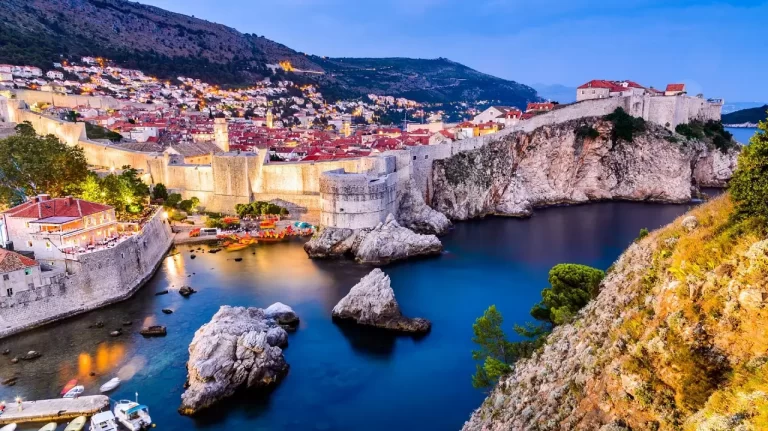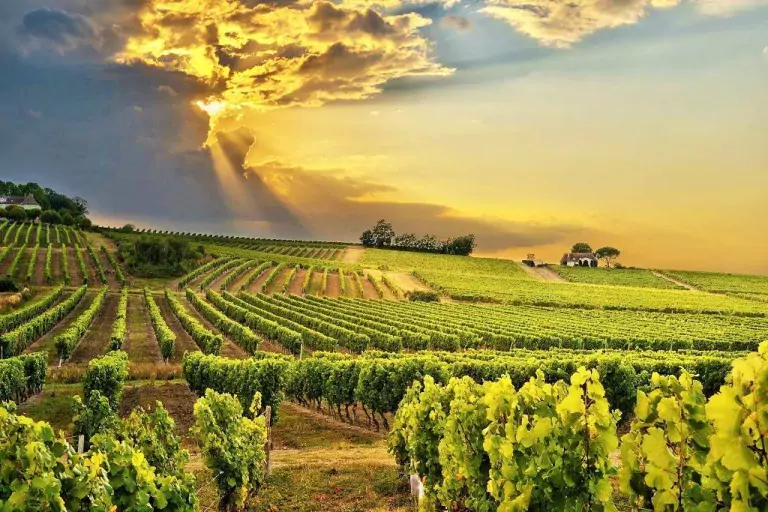Exploring Portugal
Table of Contents
ToggleFrom the South to the North, exploring Portugal took us through the vibrant streets of Lisbon, the sun-kissed beaches of the Algarve, the majestic charm of Porto, and the hidden gems of Nazaré, Aveiro, Braga, and Coimbra. With each step, we immersed ourselves in a symphony of culture, cuisine, and captivating sights.
Having made plans to immigrate to Portugal under the D7 visa , we visited Portugal in the height of winter! We figured if we saw it at its worst it could only get better. Our fourteen day road trip saw us exploring Portugal and it’s major cities in a search of our new home town. The rain was not going to get us down and with most expats wanting to settle in the warmer/dryer Algarve vs those wanting to settle in the north where it was a little cooler/wetter but a lower cost of living, it was a complete toss up between the two. So you just have to see it all and decide for yourself. Each town was more spectacular than the first, but we finally settle in the town of Figueira da Foz…not too south, not too north, not too dry and not too wet. Like Goldilocks we found our perfect bed. Here is an account of where our road trip took us with some background history to each town, where to stay and what to see and eat.
Lisbon: Where Past Meets Present
Lisbon, the capital of Portugal, is one of the oldest cities in Europe, predating even Rome.
Its history is woven with tales of Phoenicians, Romans, Moors, and explorers. The city’s strategic location along the Tagus River made it a hub for maritime trade and exploration during the Age of Discovery.
In 1755, Lisbon was devastated by one of history’s most powerful earthquakes, followed by a tsunami and fires. This catastrophe prompted the city’s reconstruction, resulting in the planned layout of the Baixa district, known for its grand squares and neoclassical architecture.
Elevador de Santa Justa: This ornate iron elevator, resembling a neo-Gothic tower, was built in the early 20th century to connect downtown Baixa with the Carmo Square at a higher level. Its unique design was inspired by the work of Gustave Eiffel, the architect of the Eiffel Tower in Paris.
Lisbon is the birthplace of Fado, a soulful genre of music known for its melancholic and nostalgic themes. It emerged in the 19th century and is often performed in intimate bars and restaurants. The Alfama district, with its narrow alleys and traditional taverns, remains a haven for Fado performances. We saw a performance in a local bar in Porto and was blown away by the emotion of the song, even though we had no idea what was being sung. But definitely worth booking a Fado Show with Traditional Dinner.
Belém Tower: A UNESCO World Heritage site, the Belem Tower was constructed in the 16th century as a fortress to defend the entrance to the city’s harbor. It symbolizes Portugal’s maritime power during the Age of Discovery and offers breathtaking views of the Tagus River.
The city’s vibrant street art scene has garnered international acclaim. From thought-provoking murals to colorful graffiti, the urban landscape becomes a canvas for artistic expression. The LX Factory, a former industrial complex turned creative hub, showcases some of Lisbon’s most captivating street art.
Lisbon is famously built on seven hills, each offering unique views and experiences. The iconic Tram 28 takes visitors on a journey through some of the city’s most charming neighborhoods, revealing panoramic vistas along the way.
With around 290 days of sunshine per year, Lisbon boasts a Mediterranean climate that entices both locals and visitors to explore its outdoor cafes, gardens, and terraces, basking in the city’s warm and inviting ambiance.
Iconic Landmarks: The 25 de Abril Bridge, resembling San Francisco’s Golden Gate Bridge, connects Lisbon to the Almada district across the Tagus River. The Cristo Rei statue, reminiscent of Rio de Janeiro’s Christ the Redeemer, stands tall in Almada, offering panoramic views of Lisbon.
Must-See Attractions: The iconic Belem Tower stood as a sentinel of Portugal’s maritime glory. The historic Alfama district with its narrow alleys and traditional Fado music captivated our hearts and the vibrant Time Out Market offered a culinary adventure like no other. Get yourself the Lisbon Card. this gives free admission to certain attractions, discounts to others and 24/48/72 hours on public transport. A very affordable way of getting around. The Hop On Hop Off is obviously also a very good way to orientate yourself with the city, we also use these buses as taxis.
Things to Eat: Indulging in creamy pastéis de nata at Pastéis de Belém was a sweet delight, and savoring bacalhau (salted codfish) dishes showcased Portugal’s culinary prowess.
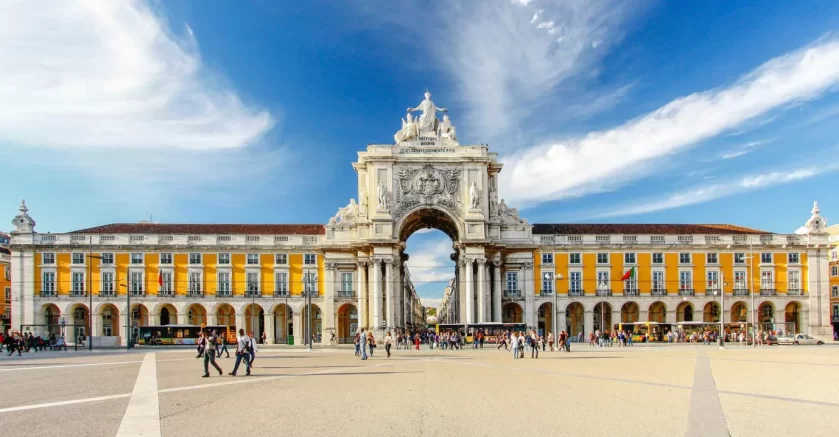
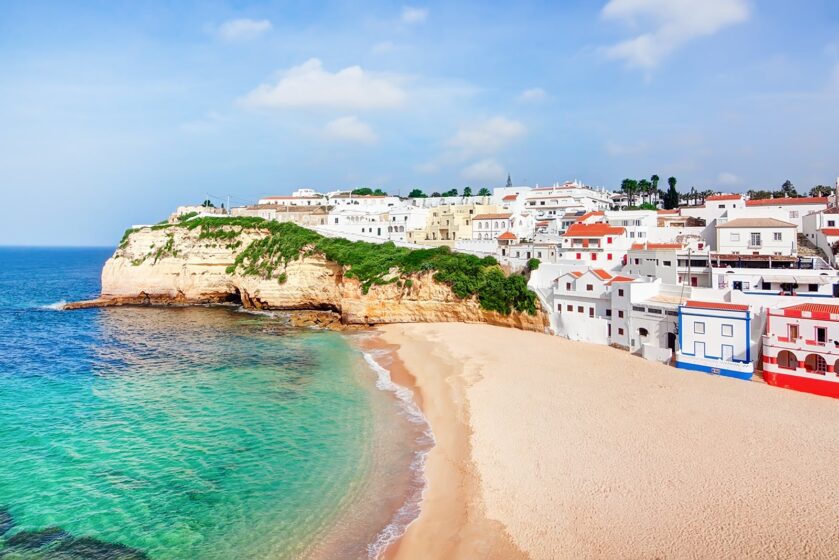
The Algarve: Sun, Sea, and Splendor
The Algarve played a crucial role in Portugal’s Age of Exploration during the 15th and 16th centuries. It was from Lagos that many of the great Portuguese explorers, such as Vasco da Gama and Ferdinand Magellan, set sail on their journeys to unknown lands.
Silhouetted against the skyline of Silves, the Castelo dos Mouros (Castle of the Moors) is a testament to the region’s Moorish past. Constructed in the 8th century, the castle stands as a reminder of the Algarve’s historical significance during the Islamic rule.
Fishing has been a cornerstone of Algarvian culture for centuries. The town of Olhão, with its iconic cube-shaped houses, is home to one of the region’s oldest fish markets, where fishermen bring in their daily catch of seafood that has sustained communities for generations.
Praia da Marinha is renowned as one of the most beautiful beaches in the world, adorned with stunning cliffs, crystal-clear waters, and natural rock formations. This beach’s natural beauty reflects the region’s unspoiled coastal charm.
Carved by centuries of sea erosion, the Algar Seco rock formations near Carvoeiro are a fascinating example of the Algarve’s geological history. Walkways and viewpoints offer breathtaking vistas of the sculpted cliffs and arches.
The Algarve is home to the largest cork forest in the world, known for producing over half of the world’s cork supply. Cork trees are a vital part of the landscape, and the industry is deeply ingrained in the local economy.
The annual sardine festival in Portimão celebrates the region’s maritime heritage. Grilled sardines are a culinary highlight, enjoyed in abundance during this lively event that pays homage to the Algarve’s fishing culture.
Algarvian architecture is known for its distinctive chimneys, often adorned with intricate patterns and designs. These chimneys are a reflection of the region’s Moorish influence and its unique architectural identity.
Must-See Attractions: The stunning cliffs of Ponta da Piedade offered awe-inspiring views of the turquoise waters below. The historic town of Lagos narrated tales of explorers from days gone by. Praia da Marinha, one of the most beautiful beaches in the world, was a paradise found.
Things to Eat: Fresh seafood platters laden with grilled sardines and succulent prawns, paired with local vinho verde, embodied coastal indulgence.
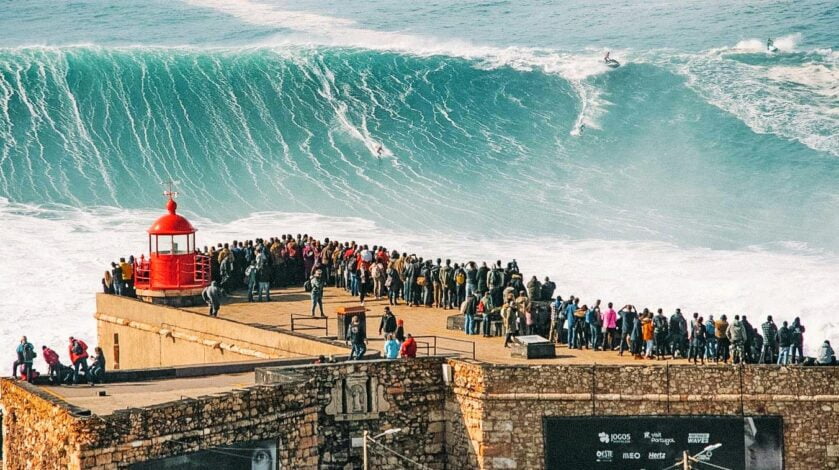
Nazaré: Where Waves Touch the Sky
Nazaré’s history is deeply intertwined with its fishing heritage. For centuries, the men of Nazaré set sail in their colorful boats, known as “bateiras,” to brave the Atlantic’s unpredictable waters, symbolizing their courage and resilience.
The town’s name is said to derive from a miraculous statue of Nossa Senhora da Nazaré (Our Lady of Nazaré) that was discovered by a monk in the 12th century. The statue is believed to protect fishermen and the town’s inhabitants, and a sanctuary dedicated to her sits atop the cliffs overlooking the ocean.
Nazaré’s Praia do Norte has become world-famous for its colossal waves, some of the biggest on the planet. These waves are generated by underwater canyons and ocean currents, making the beach a magnet for surfers seeking the ultimate challenge.
In 2011, American surfer Garrett McNamara rode a wave estimated to be around 78 feet (24 meters) tall at Praia do Norte, setting a Guinness World Record for the largest wave ever surfed. This accomplishment brought international attention to Nazaré’s waves and surfing culture.
Nazaré is known for its traditional clothing, which includes the “sete saias” or “seven skirts,” worn by local women. This layered skirt ensemble is both a symbol of the town’s culture and a nod to its maritime roots.
The “varinas” were the women who waited on the beach while their husbands were at sea. These women were known for their colorful headscarves and strong presence in the town’s daily life.
The town’s religious traditions are deeply ingrained in its identity. Festivals and processions, often accompanied by traditional music and dancing, honor Nossa Senhora da Nazaré and celebrate the town’s history.
The Sítio district, located on a hill overlooking the beach, offers panoramic views of Nazaré’s coastline. The funicular ride to the top provides a breathtaking journey, leading to the Sanctuary of Nossa Senhora da Nazaré and the iconic lighthouse.
Nazaré’s culinary offerings are dominated by fresh seafood, reflecting its coastal location. From grilled sardines to caldeirada (fish stew), visitors can savor the flavors of the sea in the town’s charming restaurants.
Must-See Attractions: Witnessing surfers conquer towering waves at Praia do Norte was a thrilling spectacle. The serene Santuário de Nossa Senhora da Nazaré offered a spiritual pause. Nazare is a one night destination, so if you have seen all there is to see and have time to spare, take a 40 minute drive to Obidos. A charming walled city offering spectacular view of the surrounding area with many curio shops and restaurants to try. You will also see many shops selling sour cherry liquor (Ginja) that is served in a chocolate shot glass..try one!
Things to Eat: Savoring a seafood feast at a local tasca and relishing the traditional fish stew, caldeirada, introduced us to Nazaré’s maritime cuisine.
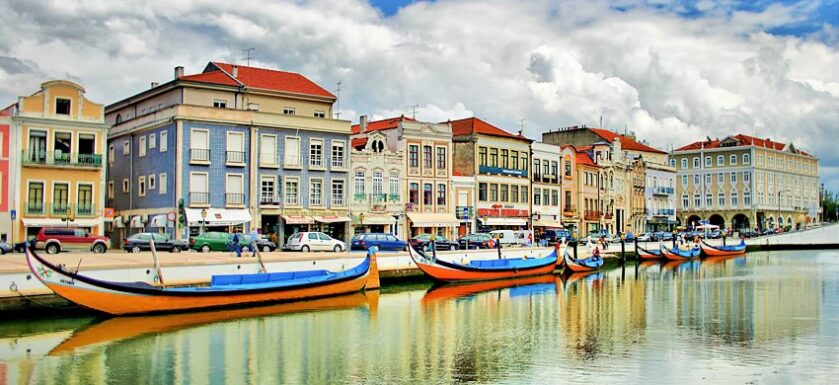
Aveiro: Venice of Portugal
Aveiro is often referred to as the “Venice of Portugal” due to its picturesque canals that meander through the city. Colorful moliceiro boats navigate these waterways, offering visitors a charming and unique perspective of the city.
Aveiro is known for its exquisite Art Nouveau architecture, with buildings adorned with ornate facades, intricate ironwork, and decorative tiles. The Aveiro Museum showcases this artistic heritage, providing insight into the city’s Belle Époque era.
The region’s salt pans have been a vital part of Aveiro’s history. The production of salt in these marshes has shaped the local economy and culture for centuries, with the famous Aveiro Sea Salt still being harvested today.
The city is home to the University of Aveiro, renowned for its cutting-edge research and innovation. Its modern campus stands in contrast to the city’s historical charm, creating a blend of tradition and progress.
Just a short drive from Aveiro, Costa Nova is a beachside village famous for its colorful striped houses and pristine sandy shores. It’s a popular spot for relaxation and offers a glimpse into the area’s maritime history.
The Santa Joana Museum, housed in a former monastery, showcases an array of artifacts that highlight the city’s history, from religious relics to archaeological treasures.
The Feira de Março, held annually since the 14th century, is one of Portugal’s oldest fairs. It’s a vibrant celebration of local culture, featuring traditional music, food, and entertainment.
The Moliceiros Festival pays homage to Aveiro’s maritime heritage, with colorful boats adorned with flowers parading through the canals. This event showcases the town’s sense of community and pride in its traditions.
Aveiro’s blend of waterways, art, and innovation creates an atmosphere that is both enchanting and forward-looking. As we explored the city’s canals, admired its Art Nouveau architecture, and savored the sweetness of ovos moles, we couldn’t help but appreciate Aveiro’s ability to harmoniously weave its past and present into a tapestry of unique experiences.
Must-See Attractions: Gliding through Aveiro’s picturesque canals on colorful moliceiro boats was a dreamlike experience, you can book this inexpensive experience HERE.
The Art Nouveau architecture of Casa de São Pedro added an artistic touch.
Things to Eat: Trying ovos moles, sweet treats wrapped in delicate rice paper, and enjoying a seafood dinner by the canal showcased Aveiro’s culinary dexterity.
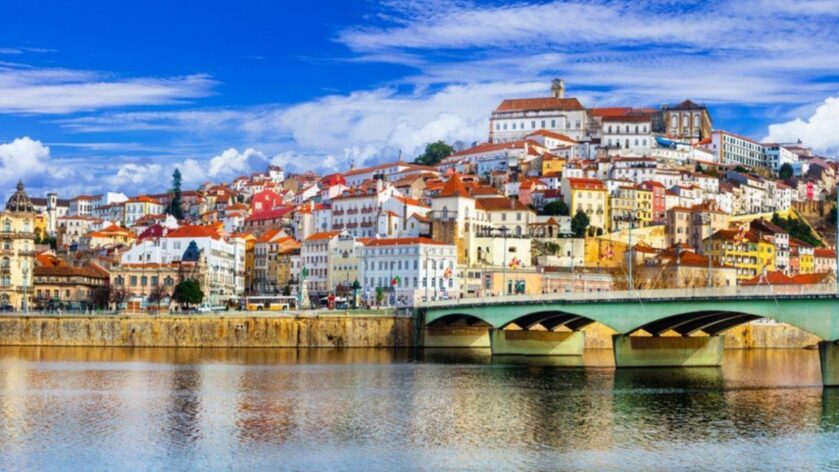
Coimbra: Where Knowledge Reigns
Coimbra is home to one of the oldest universities in continuous operation in the world, the University of Coimbra. Founded in 1290, its historical campus and academic traditions have shaped the city’s identity and attracted scholars from around the globe.
The Joanina Library, located within the university, is a true gem of Coimbra. Built in the 18th century, its ornate baroque design and impressive collection of rare books make it a symbol of knowledge and culture.
The Botanical Garden of the University of Coimbra is one of the oldest in Europe, founded in 1772. It showcases a diverse collection of plants from different continents and offers a serene escape within the city.
Coimbra is divided into two parts: Alta (Upper Town) and Baixa (Lower Town). The Alta is characterized by the university and historic sites, while the Baixa offers a more modern urban atmosphere with shops, cafes, and cultural venues.
Coimbra served as the capital of Portugal in the 12th century, during the reign of the first king, Afonso Henriques. Its hilltop position was strategic for defense and governance.
Just outside Coimbra, the Conímbriga Roman ruins offer a glimpse into the region’s ancient history. The well-preserved mosaics, baths, and structures provide insight into Roman life in Portugal.
Coimbra has its own unique style of Fado music, distinct from Lisbon’s more melancholic version. Coimbra’s Fado is often sung by male students, reflecting the city’s academic culture.
The Santa Clara-a-Velha Monastery, partially submerged by the nearby river, is an evocative site that tells the story of Coimbra’s past. It was abandoned due to flooding and has been preserved as a historical monument.
Coimbra hosts various festivals and cultural events throughout the year, including the Queima das Fitas, a vibrant celebration that marks the end of the academic year.
Must-See Attractions: The historic University of Coimbra, with its grand Joanina Library and stunning botanical garden, celebrated knowledge and history.
Things to Eat: Tasting the unique flavors of chanfana, a slow-cooked goat stew, and delighting in Coimbra’s signature dessert, Santa Clara pastries, was a culinary experince.
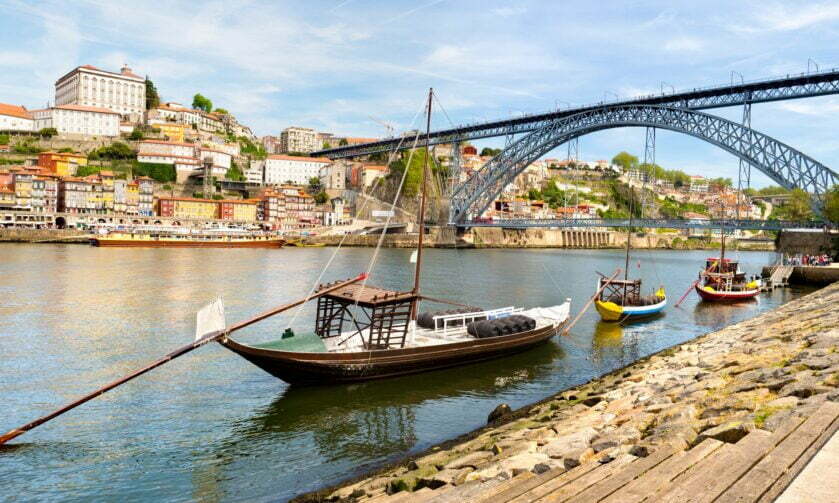
Porto: Of Wine and Wonders
The city’s name, Porto, derives from “Portus,” the Latin word for port. This name reflects Porto’s historical significance as a maritime hub and trading center along the Douro River.
Porto’s historic Ribeira district is a UNESCO World Heritage site, known for its colorful buildings, narrow streets, and the iconic Dom Luís I Bridge. This area was the heart of the city’s commercial activities during the Middle Ages.
Porto is synonymous with Port wine, a fortified wine produced in the Douro Valley. The city’s proximity to the valley led to its status as a center for the production, storage, and distribution of this beloved Portuguese beverage.
Designed by Gustave Eiffel’s apprentice, Théophile Seyrig, the Dom Luís I Bridge is an architectural marvel connecting Porto to Vila Nova de Gaia. Its double-deck design accommodates pedestrians, vehicles, and the historic Porto tram.
Livraria Lello, often referred to as one of the most beautiful bookstores in the world, is a stunning example of Art Nouveau architecture. Its ornate wooden staircases and stained-glass windows have inspired many, including J.K. Rowling, who reportedly drew inspiration for the Hogwarts staircase from here. There are ALWAYS queue’s so be sure to prepurchase your tickets for a general access line or a specific time slot.
Porto’s azulejos, intricately designed ceramic tiles, adorn many buildings across the city. These tiles often depict scenes from Portugal’s history, religion, and culture, adding an artistic touch to the urban landscape.
The Torre dos Clérigos is one of Porto’s most recognizable landmarks. Visitors who climb the tower are rewarded with panoramic views of the city’s rooftops, the Douro River, and beyond.
Porto’s historic significance isn’t limited to its architecture; it also played a crucial role during the Industrial Revolution. The Palácio de Cristal Gardens, originally built for a grand exhibition in 1865, is a reminder of the city’s industrial achievements.
Porto’s enchanting atmosphere and architecture are believed to have influenced J.K. Rowling’s descriptions of the magical world in her Harry Potter series. Some even say that the university’s student robes inspired the distinctive Hogwarts uniforms.
Must-See Attractions: The Douro River’s Ribeira district unveiled Porto’s charm with its colorful buildings and iconic Dom Luís I Bridge. Do the 6 Bridge Tour , visit the old harbor, explore the centuries-old wine cellars in Vila Nova de Gaia by taking the pedestrian walk over the bridge and the cable car down to the river boardwalk. And being in the Douro region a wine tasting river cruise with lunch is a MUST!
Things to Eat: Contrary to popular belief the peri peri chicken is not the national dish of Portugal, in my opinion the Francesinha sandwich would be. You see them everywhere, and each restaurant has their own secret recipe for the sauce. Its quite contested as to who has the best sauce. But be warned…go hungry, because this is all you will eat for the day! Pair it with a glass of Port wine for an authentic taste of the city.
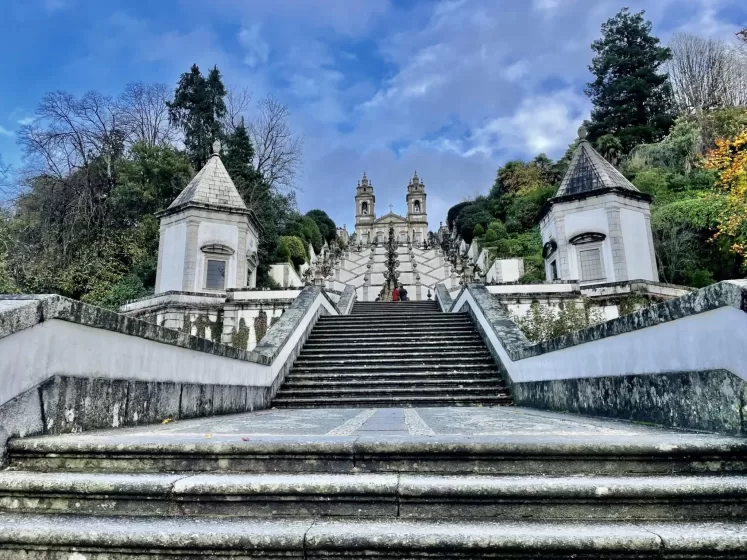
Braga: City of Baroque Wonders
Braga is one of Portugal’s oldest cities, with its history dating back to Roman times. It was known as “Bracara Augusta” during the Roman Empire and played a significant role in the region’s governance.
The Bom Jesus do Monte Sanctuary, perched on a hill overlooking Braga, is a masterpiece of Baroque architecture. Its monumental staircase, adorned with fountains and sculptures, is a testament to the city’s religious devotion and artistic heritage.
Braga is known as the “Rome of Portugal” due to its historical and ecclesiastical significance. It has been an archdiocese since the 4th century and played a central role in Portugal’s Christianization.
The Sé Cathedral of Braga is one of the country’s oldest cathedrals, dating back to the 12th century. Its architectural styles range from Romanesque to Gothic, reflecting the city’s evolution over the centuries.
The city is characterized by its stunning arches and arcades, which line its streets and squares. These architectural elements are a nod to Braga’s Roman and medieval heritage.
Braga is known for its grand Semana Santa (Holy Week) celebrations, which attract pilgrims and visitors from around the world. The processions, religious rituals, and events highlight the city’s deep-rooted faith and traditions.
Capela dos Coimbras: This small chapel is famous for its exuberant and intricate Rococo decoration. It’s a hidden gem that showcases Braga’s artistic and architectural prowess.
The D. Diogo de Sousa Museum offers insight into Braga’s rich archaeological history, with artifacts spanning from prehistoric times to the medieval era.
While deeply rooted in history, Braga has also embraced modernity, with a vibrant cultural scene, innovative universities, and contemporary architecture that harmoniously coexist with its ancient sites.
Must-See Attractions: Bom Jesus do Monte’s monumental staircase led us to panoramic views of Braga. The ornate Sé Cathedral narrated tales of the city’s religious heritage. While you are in Braga, it worth taking a 20 minute drive to the town of Barcelos, the “birth place” of Portugal and the origin of the infamous chicken.
Things to Eat: Savoring a traditional cozido à portuguesa, a hearty meat and vegetable stew, introduced us to Braga’s wholesome cuisine.
Obrigado Portugal!
Touring through Portugal you will be amazed by its untouched beauty and simplicity of life with an emphasis on family and traditional values. We embraced Portugal with open arms and it gave us a big hug back. The people are friendly, welcoming and hospitable with the majority speaking English. The language barrier was not much of an issue, but it definitely helps knowing a few key words.
We now live here full time and look forward to achieving our Portuguese citizenship.


